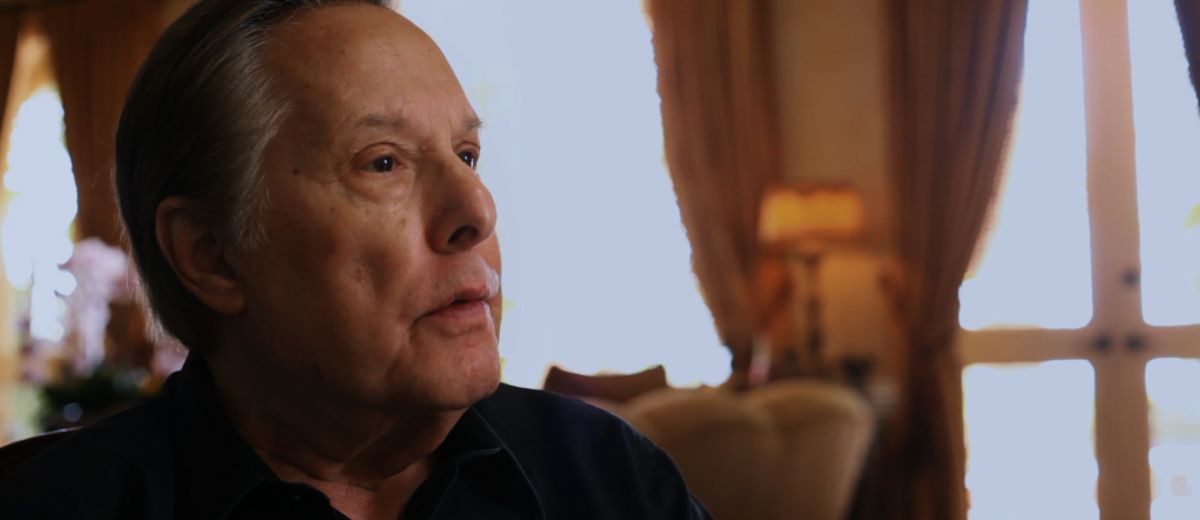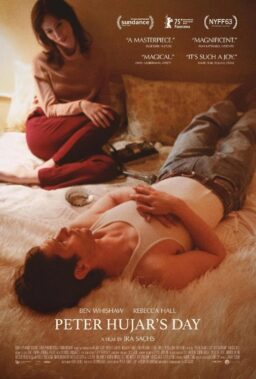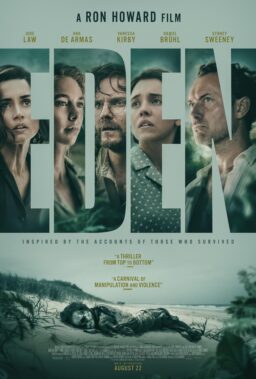It is practically a law that any major film festival has to program a couple of titles that deal specifically with the history of cinema. That was definitely the case with this year’s Chicago International Film Festival, which included two feature-length documentaries covering the histories of two notable American filmmakers that come complete with wide arrays of clips from the filmographies of their respective subjects, a number of famous faces turning up to offer their insights, and, in the case of one of them, observations from the filmmaker himself about his life and work. In terms of form and structure, the films—“Friedkin Uncut,” Francisco Zippel’s take on the often-controversial career of William Friedkin, and “The Great Buster,” Peter Bogdanovich’s celebration of Buster Keaton, arguably the greatest of all the silent movie comedians—are strikingly similar and even share a talking head commentator or two. In terms of effectiveness, however, the difference between the two is quite noticeable.
Much like “De Palma” (2015), Jake Kasdan and Noah Baumbach’s great look at the career of an iconoclastic and often-controversial filmmaker, Zippel sits Friedkin down with a cup of coffee (turns out he really likes the stuff) to talk about his films. Eschewing a chronological presentation, Zippel jumps back and forth in time and kicks things off with Friedkin’s most famous film, the groundbreaking 1973 horror classic “The Exorcist.” From there, the film moves back in time to Friedkin talking about growing up in Chicago and going to work at WGN Television, a job that eventually lead, following a fateful conversation with the chaplain at the Cook County jail, to his first film, “The People Versus Paul Crump” (1962), a documentary about a seemingly innocent prisoner sentenced to die that was so powerful and convincing that it actually led to Crump’s conviction being overturned and his being set free.
“And then I went to Hollywood,” Friedkin remarks as the film shifts forward to “The French Connection” (1971), the powerful crime thriller in which Friedkin (who won the Oscar for Best Director, one of the five the film received) applied the documentary techniques he had honed over the years to a straightforward narrative with results so strong and intense that, even after nearly 50 years since its initial release, it has lost none of its impact. From there, it leaps further ahead to “Killer Joe” (2011), one of two startling screen adaptations of the works of playwright Tracy Letts. The film then goes back to look at “Sorcerer” (1977), his reimagining of Henri-George Clouzot’s 1953 about four desperate men transporting dangerously unstable nitroglycerin over rough jungle terrain so it can be used to put out an oil rig fire, a work that was a wildly expensive flop when it first came out but which is now often cited as one of Friedkin’s greatest works as well as one of the most thrilling action films ever made. Friedkin the recounts the controversy surrounding “Cruising” (1980) and how its plot—in which Al Pacino plays a cop going undercover in New York’s S&M-heavy homosexual underground to catch a serial killer—incurred the wrath of the gay community even as it was in the middle of production. That segues into “To Live and Die in L.A.” (1985), which he describes as “just another cop film” but which, as anyone who has seen it can attest, is anything but that.
Unlike the De Palma film, where the only voice heard was De Palma’s, Zippel has recruited an impressive array of famous faces—including friends, co-workers and admirers—to further venerate Friedkin that includes everyone from the usual suspects such as Ellen Burstyn, Francis Coppola, William Petersen, Willem Dafoe and Quentin Tarantino to more unexpected observers like Wes Anderson, Damien Chazelle and Zubin Mehta, who Friedkin worked with on a production of the opera “Wozzeck.” They speak about some of the hallmarks of Friedkin’s cinematic approach, such as his deft eye for cast (Petersen and Juno Temple talk about being cast, respectively, in “To Live and Die in L.A.” and “Killer Joe,” despite not being well-known and there is a long anecdote about how his hiring of playwright Jason Miller to play Father Karras in “The Exorcist” despite the fact that Stacy Keach had already been cast in the role) and his dedication to presenting things in the most realistic manner possible (which led to a visit by Treasury agents to the set of “To Live and Die in L.A.” who were concerned he would be showing audiences exactly how to make counterfeit money).
All of this is entertaining enough to watch, I suppose, but those coming to this film with even just a tenuous knowledge of Friedkin’s career (and that is likely to be the majority of the potential audience) are going to find it to be a somewhat frustrating experience. For starters, a good chunk of his filmography—including early works like the Sonny & Cher vehicle “Good Times” (1967) and adaptations of Harold Pinter’s “The Birthday Party” (1968) and Mart Crowley’s “The Boys in the Band” (1970), later projects like “Jade” (1995), “Rules of Engagement” (2000) and “The Hunted” and a slew of TV work ranging from one of the last episodes of “Alfred Hitchcock Presents” to a 1997 take on “12 Angry Men”—are ignored completely. Now honestly, I don’t think that anyone wants to hear long stories about the history of the misfired black comedy “Deal of the Century” (1983) or the dopey horror potboiler “The Guardian” (1990) but I would have liked to hear about the strange story of “Rampage,” a film about a liberal-minded D.A. arguing that a serial killer is indeed sane enough to face the death penalty for his crimes instead of being found not guilty for reasons of insanity and have his life spared—originally produced in 1987, the film fell into a distribution black hole for five years and by the time it emerged, Friedkin had recut it so that its one-time anti-death penalty thrust was changed into a more unambiguous pro-death penalty slant.
As for the films that Friedkin does talk about, he is engaging and garrulous enough—as anyone who has seen him do a Q&A before, he is truly a raconteur for the ages—but as entertaining as he is to listen to, he doesn’t really have anything new or particularly incisive to say about his work. Granted, I presume that he is probably sick and tired of answering questions about “The Exorcist” but even with films that probably don’t come up all the time, his talk quite digs deep in the way that he did in his fascinating and eminently readable autobiography The Friedkin Connection. Evidently fearing the temper that was also legendary during his heyday, Zippel never seems to press him on anything in order to get him to say anything other than what appears to be an array of well-worn anecdotes. Make no mistake, Willian Friedkin is a great and groundbreaking filmmaker who clearly deserves a place in the pantheon. Alas, “Friedkin Uncut” is simply not worthy of the man and his cinematic legacy.

“The Great Buster” is a more effective tribute to the work of its subject. Wearing both his filmmaker and film historian hats, Bogdanovich essentially splits his film into two sections. In the first, which covers roughly the first two-thirds of the film, he recounts Buster Keaton’s often chaotic personal and professional lives, from when he joined his parents in their vaudeville act at the age of four—which basically consisted of his being thrown across the stage in moves that would probably be considered child abuse today—to his first big breakthrough when he signed up to work with the famed comedian Fatty Arbuckle on a series of two-reelers in 1917. After serving in WWI, he returned to the film industry and began writing, directing and starring in a series of 19 increasingly ambitious shorts between 1920 and 1923 before finally getting the chance to join the big leagues. Over the next five years, he would direct 10 increasingly ambitious features that have gone on to become celebrated as some of the greatest silent comedies—hell, silent films—ever produced. Alas, that string ended when he elected to give up his independence to sign up with MGM, despite being urged not to do so by such fellow comic icons as Charlie Chaplin and Harold Lloyd.
This move yielded one undeniably great movie, “The Cameraman” (1928) but the combination of intense studio meddling (including a failed attempt to make him part of a comedy duo with Jimmy Durante), a troubled marriage and an alcohol problem led to his being fired by the studio in 1933 and then suffering from a nervous breakdown. After taking time to heal and sober up, he went back to work doing everything from low-budget shorts to serving as a $100-a-week gagman at MGM for people like the Marx Brothers (this after having earned $3,000 per week just a few short years earlier). This story turned out to have a more upbeat ending than one might expect, however. With his third and final marriage in 1940 to Eleanor Norris, his personal life straightened up and when the advent of television brought renewed interest in his films, he eked out a lucrative gig as a commercial pitchman whose ads displayed flashes of his celebrated visual humor. There was an Honorary Oscar in 1960 and the latter years of his career saw him turn up in a variety of films ranging from dramas like “Sunset Blvd” (1950) and “Limelight” (1952) to major productions like “A Funny Thing Happened on the Way to the Forum” (1966) to amiable nonsense like “Beach Blanket Bingo” (1965) and “How to Stuff a Wild Bikini” (1965). When he finally passed in 1966, he may not have had a smile on his legendary stone face but at least he knew how much people appreciated him and his work.
Bogdanovich gets through this material in a breezy and efficient manner and is aided by his own collection of famous faces offering insight that includes Mel Brooks, Dick Van Dyke, Leonard Maltin, Johnny Knoxville, Bill Hader, Cybil Shepard, Carl Reiner, French Stewart (?) and, perhaps inevitably, Quentin Tarantino. Of them, the most memorable is the legendary filmmaker Werner Herzog, who pretty much sums it all up when he simply states “Buster Keaton is the essence of the movies. How effective this all is from a historical perspective will no doubt depend on your previous familiarity with Keaton and his work. For those who don’t know much about him, or silent cinema in general, “The Great Buster” will serve as a better-than-average primer that gives all of the necessary historical information in a straightforward and educational manner without making the subject at hand feel like a drag in the process. For those whose knowledge of film history is more advanced, it could be argued that he doesn’t dig quite as deep into his subject as he could and that he perhaps dwells a little too heavily on the purely mechanical aspects of Keaton’s filmmaking style without delving into the other contents of his directorial bag of tricks that made his films far more than just simply collections of gags. However, when it comes between playing to the choir or trying to reach out to potential new devotees, Bogdanovich has clearly opted to do the latter and in the end, that was probably the smarter approach.
Whether one is a hardcore fan of Keaton, or someone completely unfamiliar with his oeuvre, they will still be blown away with the final third of the film, in which Bogdanovich skips back to present judiciously selected clips from those 10 classic features from his 20s heyday. The chariot race from “The Three Ages” (1923), his elaborate spoof of D.W. Griffith’s multiple era epic “Intolerance.” The jaw-dropping, how-did-they-do-that? moment in “Our Hospitality” (1923), in which he finds himself in the center of a Hatfiled-McCoy-style rivalry in which he swings to his beloved’s rescue just as she is about to go over a waterfall. The dazzling dream sequence in the influential “Sherlock Jr.” (1924) in which he, playing a film projectionist dozing off at work, finds himself entering the movie screen and landing in a series of increasingly dangerous settings. The elaborate sequence in “The Navigator” (1924), which he made largely because he was able to get his hands on an ocean liner, in which he and the girl who just dumped him end up all alone on an otherwise empty ship at sea and eventually discover the presence of each other. The knockout conclusion of “Seven Chances” (1925) in which his character finds himself literally caught between a rock and a hard place—in this case, an ever-increasing mob of marriage-minded women and an avalanche of boulders. The sweet moment in “Go West” (1925) when, not wanting to hurt the cow he has grown inordinately fond of by branding it, winds up shaving a brand on it with the aid of some of her milk that he uses as cream. The scene in “Battling Butler” (1926) when he attempts to shoot a duck in a river from the confines of a tiny kayak—a sequence that is funny and elaborate enough at first glance but which becomes astounding when you realize that it has been done in one single take. It is impossible to name only one great sequence from his 1926 epic “The General,” of course, but the stunning shot of the train plunging from a collapsing bridge into a river (the most expensive single shot in silent film history) will certainly suffice. The brilliantly timed slapstick sequence in “College” (1927) where he tries to emulate the moves of a slick soda jerk with hilariously messy results. And, of course, the moment in the final film of this run, “Steamboat Bill Jr.” (1928), that is perhaps the most famous of his career—the often-copied, never-topped sight gag in which the side of a full size house collapses on him but he is unscathed since his body passes through the small area left by an empty window frame, a joke that literally could have killed him if he had been an inch or so off target.
Under normal circumstances, I have a problem with clip jobs like that—by presenting such scenes without any kind of narrative context, the big moments lose their significance and make you wish you had just watched the entire movie instead. In this sequence, which lasts roughly 40 minutes, Bogdanovich has compiled them in an efficient manner that allows you to admire and laugh at some of the greatest moments in the history of all screen comedy. Furthermore, he manages to find a way to explain the mechanics of the scenes and why they are funny without sucking any of the humor out of them in the process. Thanks to his carefully considered approach to the subject, “The Great Buster,” while not quite the definitive documentary that Keaton’s life and work deserves, is still an eminently watchable, largely entertaining and occasionally educational take on the subject at hand. If you do watch it, however, make sure that it is when you have a lot of free time available because after seeing it, you are going to want to (re)watch as much of the Keaton canon as possible afterwards.












